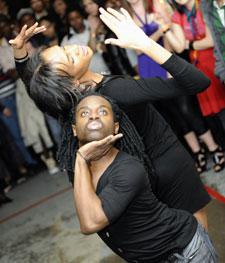
STRUT. Mother TKO Monroe of House of Monroe struts his stuff at PlayPen on Mar 14 at the Concord Café. Credit: Dominic Chan
So what’s your category? Are you Banjie or are you Cunt? I would like to think of myself as Cunt, but I’m sure there’s a lineup of upcoming legendary children who are fiercer than I (I don’t even know how to dip, let alone drop). Still I could read any one of them to filth. Then again, shadiness has never really been a category.
If you have no idea what I’m talking about then consider this your introduction to the wide world of House culture — not the track-pants-glow-stick-White-Party kind of house but the culture that was first brought to the public’s attention in Jennie Living-ston’s 1991 documentary Paris Is Burning, a kind of self-made social organization among (predominantly) black queer youth — houses, balls, voguing, realness. And if you think that this culture is an extinct relic of the ’80s then learn it child, and learn it well: Not only has house and ball culture been continuously active, it thrives (there’s even a vogue troupe on this season of America’s Best Dance Crew) and Toronto is home to Canada’s only house: the House of Monroe.
“Actually, there is a house in Vancouver,” says TKO, the House of Monroe’s mother, “but they don’t walk in any of the balls. We do, so we are the premier voguing house of Canada.” A house, to paraphrase the legendary Dorian Corey, is like a gay street gang. But that’s not the whole definition, and it certainly doesn’t encompass what it means to the Monroe children. To begin with, Houses are structured like families: They have mothers and fathers, and the membership are the children. “It means that I have a chosen family, people I can talk to who share my struggles as an LGBT youth. We’re always together,” says Jordyn Monroe. “Wherever there’s one Monroe, there’s usually a couple more down the street. That’s usually how it is. We’re close-knit and we try and take care of each other.”
The preciousness of a chosen family is a sentiment that’s echoed by all of the Monroes — Twysted, Kashmere, Mother TKO, Jordyn, Star Baby and Keisha — who sat down to talk with me. But of course, they wouldn’t be Canada’s premier voguing house if they didn’t vogue.
If you have never seen the House of Monroe in action then you have missed out. I caught a little mini-version at the Pride edition of the Hot Nuts party at the Beaver and I lost my shit. Only three Monroes performed (there are 17 in all, although not all of them are voguers) — Snoopy, Vixen and Twysted — but they ruled the floor with tight, electric group routines and individual voguing performances. By the end of their three-song set, they had completely changed the energy in the bar: Before people were listless, drinking and smoking on the patio; after the dancefloor was rammed with energized partygoers.
The Monroes are active ball-walkers, regularly travelling to New York, Buffalo, Detroit and Philadelphia to represent. “I go to almost all the balls,” says Twysted; Star Baby quickly corrects him. “Twysted, Star and Monica go to almost all the balls.” The Monroes just appeared at Icon Ball in New York.
“I walk things with a twist,” continues Twysted. “Twist meaning Realness — me being a boy, acting like a straight boy, looking like a straight boy. So I get my 10s for Realness first, then I twist into becoming a Cunt, meaning I vogue down with the girls.” Star Baby, the other avid dancer at the interview, says she walks “female figure performance. Because I’m a real girl, I walk women’s performance.” The Icon Ball was Kashmere’s first, which meant he was walking Virgin Vogue, “only because I haven’t walked a ball yet. Before you can walk any category, you have to walk Virgin.”
The Monroes’ commitment to community is deep — most of them met through community groups like Black Queer Youth and Jordyn and TKO both work in youth outreach. Their hometown shows make good on their ideals — performing all over town for all kinds of crowds. In a city like Toronto, whose communities can get very segmented very fast (Queer West versus Church St, to say nothing of the racial and ethnic divides within those subcommunities), the fact that they burn the house down everywhere they go is a testament to the power of their performances. More importantly, that kind of disregard for scenes or cliques is an amazing model of diversity.
“The house is as diverse as we can be right now,” says Mother TKO. “If you saw Paris Is Burning, you only saw people of colour, and all of them were queer. In our house, we have all different races, different sexualities, different genders, so we’re a community as much as we’re a family. We’re a community in and of ourselves.”

 Why you can trust Xtra
Why you can trust Xtra


